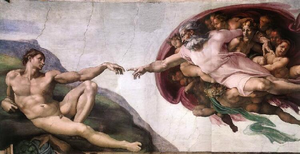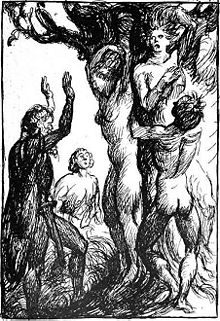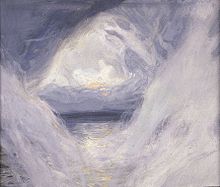- Creation myth
-
A creation myth or creation story is a symbolic account of how the world began and how people first came to inhabit it.[1][2][3] They develop in oral traditions[2] and are the most common form of myth, found throughout human culture.[4][5] In the society in which it is told, a creation myth is usually regarded as conveying profound truths, metaphorically, symbolically and sometimes even in a historical or literal sense.[4][6] They are commonly, although not always, considered cosmogonical myths—that is they describe the ordering of the cosmos from a state of chaos or amorphousness.[7] They often are considered sacred accounts and can be found in nearly all known religious traditions.[8]
Several features are found in all creation myths. They are all stories with a plot and characters who are either deities, human-like figures, or animals, who often speak and transform easily.[9] They are often set in a dim and nonspecific past, what historian of religion Mircea Eliade termed in illo tempore (English: at that time).[8][10] Also, all creation myths speak to deeply meaningful questions held by the society that shares them, revealing of their central worldview and the framework for the self-identity of the culture and individual in a universal context.[11]
Contents
Classification
Mythologists have applied various schemes to classify creation myths found throughout human cultures. Eliade and his student, Charles H. Long, developed a classification based on some common motifs that reappear in stories the world over. The classification identifies five basic types:[12]
- Creation ex nihilo in which the creation is through the thought, word, dream or bodily secretions of a divine being
- Earth diver creation in which a diver, usually a bird or amphibian sent by a creator, plunges to the seabed through a primordial ocean to bring up sand or mud which develops into a terrestrial world
- Emergence myths in which progenitors pass through a series of worlds and metamorphoses until reaching the present world
- Creation by the dismemberment of a primordial being
- Creation by the splitting or ordering of a primordial unity such as the cracking of a cosmic egg or a bringing into form from chaos
Marta Weigle further developed and refined this typology to highlight nine themes, adding elements such as deus faber, a creation crafted by a deity, creation from the work of two creators working together or against each other, creation from sacrifice and creation from division/conjugation, accretion/conjunction, or secretion.[12]
An alternative system based on six recurring narrative themes was designed by Raymond Van Over:[12]
- a primeval abyss, an infinite expanse of waters or space
- an originator deity which is awakened or an eternal entity within the abyss
- an originator deity poised above the abyss
- a cosmic egg or embryo
- an originator deity creating life through sound or word
- life generating from the corpse or dismembered parts of an originator deity
Meaning and function
All creation myths are in one sense etiological because they attempt to explain how the world was formed and where humanity came from.[3] While in popular usage the term "myth" is often thought to refer to false or fanciful stories, creation myths are by definition those stories which a culture accepts as both a true and foundational account of their human identity. Ethnologists and anthropologists who study these myths point out that in the modern context theologians try to discern humanity's meaning from revealed truths and scientists investigate cosmology with the tools of empiricism and rationality, but creation myths define human reality in very different terms. In the past historians of religion and other students of myth thought of them as forms of primitive or early-stage science or religion and analyzed them in a literal or logical sense. However they are today seen as symbolic narratives which must be understood in terms of their own cultural context. Charles H. Long writes, "The beings referred to in the myth -- gods, animals, plants -- are forms of power grasped existentially. The myths should not be understood as attempts to work out a rational explanation of deity."[13]
While creation myths are not literal explications they do serve to define an orientation of humanity in the world in terms of a birth story. They are the basis of a worldview that reaffirms and guides how people relate to both the spiritual and natural world as well as to each other. The creation myth acts as a cornerstone for distinguishing primary reality from relative reality, the origin and nature of being from non-being.[14] In this sense they serve as a philosophy of life but one expressed and conveyed through symbol rather than systematic reason. And in this sense they go beyond etiological myths which mean to explain specific features in religious rites, natural phenomena or cultural life. Creation myths also help to orient human beings in the world, giving them a sense of their place in the world and the regard that they must have for humans and nature.[1]
Types
See also: List of creation mythsEx nihilo
Main article: Ex nihiloCreation ex nihilo (Latin "out of nothing"), also known as "creation de novo", is a common type of mythical creation. Ex nihilo creation is found in creation stories from ancient Egypt, the Rig Veda, the Bible and the Quran, and many animistic cultures in Africa, Asia, Oceania and North America.[15] The Debate between sheep and grain is an example of an even earlier form of ex nihilo creation myth from ancient Sumer.[16] In most of these stories the world is brought into being by the speech, dream, breath, or pure thought of a creator but creation ex nihilo may also take place through a creator's bodily secretions. The literal translation of the phrase ex nihilo is "from nothing" but in many creation myths the line is blurred whether the creative act would be better classified as a creation ex nihilo or creation from chaos. With ex nihilo, the potential and the substance of creation springs from within the creator. Such a creator may or may not be existing in physical surroundings such as darkness or water, but does not create the world from them. In creation from chaos the substance used for creation is pre-existing within the unformed void.[17]
Creation from chaos
Main article: Chaos (cosmogony)In creation from chaos myth, initially there is nothing but a formless, shapeless expanse. In these stories the word "chaos" means "disorder", and this formless expanse, which is also sometimes called a void or an abyss, contains the material with which the created world will be made. Chaos may be described as having the consistency of vapor or water, dimensionless, and sometimes salty or muddy. These myths associate chaos with evil and oblivion, in contrast to "order" (cosmos) which is the good. The act of creation is the bringing of order from disorder, and in many of these cultures it is believed that at some point the forces preserving order and form will weaken and the world will once again be engulfed into the abyss.[18]
World parent
There are two types of world parent myths, both describing a separation or splitting of a primeval entity, the world parent or parents. One form describes the primeval state as an eternal union of two parents, and the creation takes place when the two are pulled apart. The two parents are commonly identified as Sky (usually male) and Earth (usually female) who in the primeval state were so tightly bound to each other that no offspring could emerge. These myths often depict creation as the result of a sexual union, and serve as genealogical record of the deities born from it.[19]
In the second form of world parent myth, creation itself springs from dismembered parts of the body of the primeval being. Often in these stories the limbs, hair, blood, bones or organs of the primeval being are somehow severed or sacrificed to transform into sky, earth, animal or plant life, and other worldly features. These myths tend to emphasize creative forces as animistic in nature rather than sexual, and depict the sacred as the elemental and integral component of the natural world.[20]
Emergence
In emergence myths humanity emerges from another world into the one they currently inhabit. The previous world is often considered the womb of the earth mother, and the process of emergence is likened to the act of giving birth. The role of midwife is usually played by a female deity, like the spider woman of Native American mythology. Male characters rarely figure into these stories, and scholars often consider them in counterpoint to male oriented creation myths, like those of the ex nihilo variety.[3]
Emergence myths commonly describe the creation of people and/or supernatural beings as a staged ascent or metamorphosis from nascent forms through a series of subterranean worlds to arrive at their current place and form. Often the passage from one world or stage to the next is impelled by inner forces, a process of germination or gestation from earlier, embryonic forms.[21][22] The genre is most commonly found in Native American cultures where the myths frequently link the final emergence of people from a hole opening to the underworld to stories about their subsequent migrations and eventual settlement in their current homelands.[23]
Earth-diver
The earth-diver is a common character in various traditional creation myths. In these stories a supreme being usually sends an animal into the primal waters to find bits of sand or mud with which to build habitable land. Some scholars interpret these myths psychologically while others interpret them cosmogonically. In both cases emphasis is placed on beginnings emanating from the depths.[24] Earth-diver myths are common in Native American folklore but can be found among the Chukchi and Yukaghir, the Tatars and many Finno-Ugrian traditions. The pattern of distribution of these stories suggest they have a common origin in the eastern Asiatic coastal region, spreading as peoples migrated west into Siberia and east to the North American continent.[25]
Characteristic of many Native American myths, earth-diver creation stories begin as beings and potential forms linger asleep or suspended in the primordial realm. The earth-diver is among the first of them to awaken and lay the necessary groundwork by building suitable lands where the coming creation will be able to live. In many cases, these stories will describe a series of failed attempts to make land before the solution is found.[26]
See also
- Cosmogony
- Creationism
- Evolutionary origin of religions
- List of creation myths
- Myth of origins
- Origin of death myth
- World egg
Notes
- ^ a b Encyclopædia Britannica 2009
- ^ a b Womack 2005, p. 81, "Creation myths are symbolic stories describing how the universe and its inhabitants came to be. Creation myths develop through oral traditions and therefore typically have multiple versions."
- ^ a b c Leeming 2005
- ^ a b Kimball 2008[page needed]
- ^ Long 1963, p. 18
- ^ Leeming 2010, pp. xvii-xviii; 465
- ^ See:
- ^ a b Johnston 2009
- ^ See:
- ^ Eliade 1963, p. 429
- ^ See:
- ^ a b c Leonard & McClure 2004, p. 32–33
- ^ Long 1963, p. 12
- ^ Sproul 1979, p. 6
- ^ Leeming 2010, pp. 1–3,153
- ^ Wasilewska 2000, pp. 146
- ^ Leeming & Leeming 1994, p. 60–61
- ^ Leeming 2010
- ^ Leeming 2010, p. 16
- ^ Leeming 2010, p. 18
- ^ Leeming 2010, pp. 21–24
- ^ Long 1963
- ^ Wheeler-Voegelin & Moore 1957, pp. 66–73
- ^ Leeming 2011b
- ^ Booth 1984, pp. 168–170
- ^ Leonard & McClure 2004, p. 38
References
- Ashkenazi, Michael (2008). Handbook of Japanese mythology (illustrated ed.). ABC-CLIO. ISBN 156074684.
- Barbour, Ian G. (1997). Religion and Science: Historical and Contemporary Issues (first revised ed.). HarperSanFrancisco. pp. 58, 65. ISBN 0060609389.
- Bastian, Dawn E.; Mitchell, Judy K. (2004). Handbook of Native American Mythology. Santa Barbara: ABC-CLIO. ISBN 1851095330.
- Boas, Franz (1916). "Tsimshian Mythology". Annual Report of the Bureau of American Ethnography. Government Printing Office. http://books.google.com/?id=3WwqAAAAMAAJ&pg=PA651#v=onepage&q.
- Bodde, Derk (1961). "Myths of Ancient China". In Samuel Noah Kramer. Mythologies of the Ancient World. Anchor.
- Booth, Anna Birgitta (1984). "Creation myths of the North American Indians". In Alan Dundes. Sacred Narrative: Readings in the Theory of Myth. University of California Press. ISBN 978-0520051928.
- Courlander, Harold (2002). A Treasury of African Folklore: The Oral Literature, Traditions, Myths, Legends, Epics, Tales, Recollections, Wisdom, Sayings, and Humor of Africa. Marlowe & Company. ISBN 9781569245361.
- Merriam-Webster's Collegiate Encyclopedia (2000). "creation myth". ISBN 0877790175.
- Merriam-Webster's Encyclopedia of World Religions (1999). "Creation Myth". Merriam-Webster. ISBN 0877790442.
- Doty, William (2007). Myth: A Handbook. University Alabama Press. ISBN 978-0817354374.
- Frank; Leaman, Oliver (2004). History of Jewish Philosophy. Psychology Press. ISBN 9780415324694. http://books.google.com/books?id=zLxBQrY6inEC.
- Eliade, Mircea (1963). Patterns in comparative religion. The New American Library-Meridian Books. ISBN 9780529019158.
- Sweetman, James Windrow (2002). Islam and Christian Theology. James Clarke & Co.. ISBN 9780227172032. http://books.google.com/books?id=q_Gqxe2ZDqkC.
- Encyclopædia Britannica (2009). "myth". Encyclopædia Britannica Online. http://search.eb.com/eb/article-9108748.
- Giddens, Sandra; Giddens, Owen (2006). African Mythology. The Rosen Publishing Group. ISBN 1404207686.
- Honko, Lauri (1984). "The Problem of Defining Myth". In Alan Dundes. Sacred Narrative: Readings in the Theory of Myth. University of California Press. ISBN 978-0520051928.
- Johnston, Susan A. (2009). Religion, Myth, and Magic: The Anthropology of Religion-a Course Guide. Recorded Books, LLC. ISBN 978-1-4407-2603-3.
- Kimball, Charles (2008). "Creation Myths and Sacred Stories". Comparative Religion. The Teaching Company. ISBN 1598034529.
- Knappert, Jan (1977). Bantu Myths and Other Tales. Brill Archive. ISBN 9004054235.
- Leeming, David A. (2010). Creation Myths of the World (2nd ed.). ABC-CLIO. ISBN 978-1598841749.
- Leeming, David Adams; Leeming, Margaret Adams (2009). A Dictionary of Creation Myths (Oxford Reference Online ed.). Oxford University Press. ISBN 0195102754.
- Leeming, David Adams; Leeming, Margaret Adams (1994). A Dictionary of Creation Myths. Oxford University Press. ISBN 9780195102758.
- Leeming, David Adams; Leeming, Margaret Adams (1994). Encyclopedia of Creation Myths (2nd ed.). ABC-CLIO. ISBN 978-0874367393.
- Leeming, David A. (2001). Myth: A Biography of Belief. Oxford University Press. ISBN 978-0195142884.
- Leeming, David A. (2011a). "Creation". The Oxford companion to world mythology (online ed.). Oxford University Press. http://www.oxfordreference.com/views/ENTRY.html?subview=Main&entry=t208.e358. Retrieved 13 October 2011.
- Leeming, David A. (2011b). "Earth-Diver Creation". The Oxford companion to world mythology (online ed.). Oxford University Press. http://www.oxfordreference.com/views/ENTRY.html?subview=Main&entry=t279.e87. Retrieved 13 October 2011.
- Leonard, Scott A; McClure, Michael (2004). Myth and Knowing (illustrated ed.). McGraw-Hill. ISBN 9780767419574.
- Littleton, C. Scott (2005). Gods, goddesses, and mythology. 1. Marshall Cavendish. ISBN 9780761475590.
- Long, Charles H. (1963). Alpha: The Myths of Creation. New York: George Braziller.
- Mair, Victor H. (1990). Tao Te Ching: The Classic Book of Integrity and the Way, by Lao Tzu. Bantam Books. ISBN 0553070053.
- MacClaglan, David (1977). Creation Myths: Man's Introduction to the World. Thames & Hudson. ISBN 978-0500810101.
- Nassen-Bayer; Stuart, Kevin (1992-10). Mongol creation stories: man, Mongol tribes, the natural world and Mongol deities. 2. 51. Asian Folklore Studies. pp. 323–334. http://ccbs.ntu.edu.tw/FULLTEXT/JR-EPT/stuart1.htm. Retrieved 2010-05-06.
- MacClaglan, David (1977). Creation Myths: Man's Introduction to the World. Thames & Hudson. ISBN 978-0500810101.
- Segal, Robert (2004). Myth: A Very Short Introduction. Oxford University Press. ISBN 978-0192803474.
- Sproul, Barbara C. (1979). Primal Myths. HarperOne HarperCollinsPublishers. ISBN 9780060675011.
- Stocker, Terry (2009). The Paeolithic Paradigm. AuthorHouse. ISBN 1449022928.
- Thomas, Cullen (2008). Brother One Cell: An American Coming of Age in South Korea's Prisons. Penguin. ISBN 0143113119.
- Wasilewska, Ewa (2000). Creation stories of the Middle East. Jessica Kingsley Publishers. ISBN 9781853026812. http://books.google.com/books?id=sMj1tyho3CoC&pg=PA146. Retrieved 23 May 2011.
- Wheeler-Voegelin, Erminie; Moore, Remedios W. (1957). "The Emergence Myth in Native North America". In W. Edson Richmond. Studies in Folklore, in Honor of Distinguished Service Professor Stith Thompson. Indiana University Press. ISBN 9780837162089.
- Weigle, Marta (1987). "Creation and Procreation, Cosmogony and Childbirth: Reflections on Ex Nihilo Earth Diver, and Emergence Mythology". Journal of American Folklore 100 (398).
- Winzeler, Robert L. (2008). Anthropology and religion: what we know, think, and question. AltaMira Press. ISBN 978-0-7591-1046-5.
- Womack, Mari (2005). Symbols and Meaning: A Concise Introduction. AltaMira Press. ISBN 978-0759103221.
- Y.Z. (June 1824). "Some Account of the Tangousians in general and the Transbaikal Tangousians in particular". Asiatic journal and monthly miscellany. 17. Wm. H. Allen & Co. http://books.google.com/?id=8w8oAAAAYAAJ&pg=PA595#v=onepage&q.
External links
Categories:- Creation myths
- Mythological cosmologies
- Comparative mythology
Wikimedia Foundation. 2010.




